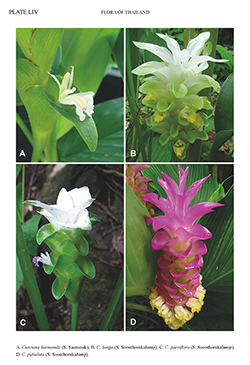e-Flora of Thailand
Volume 16 > Part 2 > Year 2023 > Page 444 > Zingiberaceae > Curcuma
28. Curcuma longa L.wfo-0000365771
Sp. Pl. 1: 2. 1753, Leong-Škorničková et al., Bot. J. Linn. Soc. 157: 42. 2008. Plate LIV: B.
Accepted Name : This is currently accepted.
Synonyms & Citations :
Description : Rhizome branched, main rhizome ovoid, 3–6 by 2–4 cm; first order branches to ca 10 cm long, 1–2 cm diam., second order branches shorter and perpendicular to first order branches, internally bright yellow-orange to orange, strongly aromatic with carrot-like smell and taste; root tubers not seen. Leafy shoot to 1.2 m tall with 5–8 leaves; bladeless sheaths 2–4, green, glabrous, soon decaying; leaf sheaths green, glabrous; ligule obscurely bilobed, ca 2 mm long, semitranslucent greenish, glabrous; blades narrowly ovate, ovate to elliptic, 25–65 by 8–18.5 cm, plicate, green and glabrous on both surfaces, base cuneate to rounded, apex acuminate; petiole 5–30 cm long, green, glabrous. Inflorescence central, 15–30 cm long; peduncle 10–15 cm long; thyrse cylindrical, 10–16 by 6–8.5 cm, composed of 15–35 bracts; fertile bracts ovate to elliptic with broadly acute to rounded apex, 4–5 by 2–3.5 cm, light green, puberulent on both surfaces; cincinni with 6–9 flowers at basal bracts; coma bracts narrowly ovate to elliptic, 4–6.5 by 1–2.3 cm, pale green at base, white with pale green stripes or nearly entirely white, sometimes with very slight pink tinge at apices (hardly visible), puberulent on both surfaces; bracteoles obovate, 12–27 by 7–15 mm, folded, semitranslucent white often with greenish apex, glabrous. Flower gullet type, 4–5 cm long; ovary barrel-shaped, 3–4 by 2–3 mm, hairy; epigynous glands narrowly cylindrical with blunt apex, ca 3 mm long, pale yellow; style white, glabrous; stigma irregularly capitate with two blunt, dorsal bulges, ca 1 mm diam., ostiole ciliate; calyx 1–1.2 cm long, with unilateral incision about half length, apex shallowly tridentate, semitranslucent white, glabrous; floral tube narrowly cylindrical in basal ½, funnel-shaped distally, ca 3.5 cm long, externally pale yellow, glabrous, internally pale yellow at base, darker yellow distally, glabrous at base, densely hairy at constriction, puberulent distally; dorsal corolla lobe triangular with hooded, mucronate apex, 1.3–1.4 by 0.9–1.1 cm, semitranslucent white to cream, glabrous but sparsely puberulous at apex; lateral corolla lobes triangular with blunt, concave apex, 1.1–1.2 by 0.8–0.9 cm, semitranslucent white to cream, glabrous; lateral staminodes oblong with rounded apex, 1–1.3 by 0.7–0.9 cm, pale yellow; labellum obscurely trilobed, 1.4–1.6 by 1.4–1.6 cm, side lobes folding upwards, apex of midlobe emarginate, pale yellow with bright yellow median band; stamen ca 7 mm long; filament 3–4 mm long, 4–5 mm broad at base, ca 2 mm at point of attachment, pale yellow; anther spurred, ca 7 mm long, connective tissue cream to white, anther crest bluntly rectangular to round, ca 0.5 mm long, yellow, spurs narrowly conical, slightly compressed, ca 3 mm long, thecae ca 3 mm long, dehiscing throughout their length, pollen white. Fruit not seen.
Thailand : Widely cultivated.
Distribution : Widely cultivated in the tropics: Sri Lanka (epitype of Curcuma longa), Malaysia (Malacca – neotype of Stissera curcuma), Indonesia (Sumatra – lectotype of Curcuma domestica).
Ecology : Cultivated.
Vernacular : Khamin (ขมิ้น).
CommonName : Turmeric.
Uses: Turmeric is an important component in various Thai curry pastes. Medicinally, it is used to treat a wide variety of conditions, such as fevers, gastric ulcers, dyspepsia and other abdominal pains, sore throat, urinary stones and skin diseases. It is also used in herbal cosmetics.
Notes: The wild origin and natural distribution of cultivated Curcuma longa are not known. The name is often misapplied to similar looking species with bright orange rhizomes, but the crushed rhizomes and leaves of true turmeric have a typical smell, reminiscent of fresh carrot roots or carrot leaves, and coma bracts which are pale green with white stripes to nearly white, occasionally with a scarcely visible pink tinge, but without prominent pink apices.

